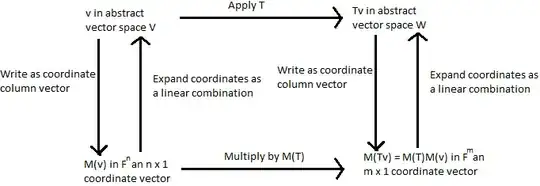In Linear Algebra Done Right, it said
Suppose $T \in \mathcal{L}(V,W)$ and $v \in V$. Suppose $v_1,...,v_n$ is a basis of $V$ and $w_1,...,w_m$ is a basis of $W$. Then $$M(Tv) = M(T)M(v)$$
$M(T)$ is the m-by-n matrix whose entries $A_{j,k}$ are defined by $Tv_k = A_{1,k}w_1 + ... + A_{m,k}w_m$ suppose $T \in \mathcal{L}(V,W)$ and $v_1,...,v_n$ is a basis of $V$ and $w_1,...,w_m$ is a basis of $W$.
$M(v)$ is the matrix of vector $v$.
I generally follow the following proof:
Suppose $v = c_1v_1 + ... + c_nv_n$, where $c_1,...,c_n \in \mathbb{F}$. Thus $$Tv = c_1Tv_1 +...+c_nTv_n$$
Hence
\begin{equation} \begin{split} M(Tv) &= c_1M(Tv_1) + ...+ c_nM(Tv_n)\\ & = c_1M(T)_{.,1} +...+c_nM(T)_{.,n} \\ & = M(T)M(v) \end{split} \end{equation}
But I have questions on the meaning of the proof. The book said it means each m-by-n matrix $A$ induces a linear map from $\mathbb{F}^{n,1}$ to $\mathbb{F}^{m,1}$. The result can be used to think of every linear map as a matrix multiplication map after suitable relabeling via the isomorphisms given by $M$.
- Is the shape of $M(Tv)$ m by 1, $M(T)$ m by n, and $M(v)$ n by 1?
- What is meant by suitable relabeling via the isomorphisms given by $M$? Does it just mean $M(T)$ is a isomorphism linear map between $M(v)$ and $M(Tv)$?
